助动词dodoesdid和be动词amisare用法的区别
- 格式:doc
- 大小:15.00 KB
- 文档页数:1
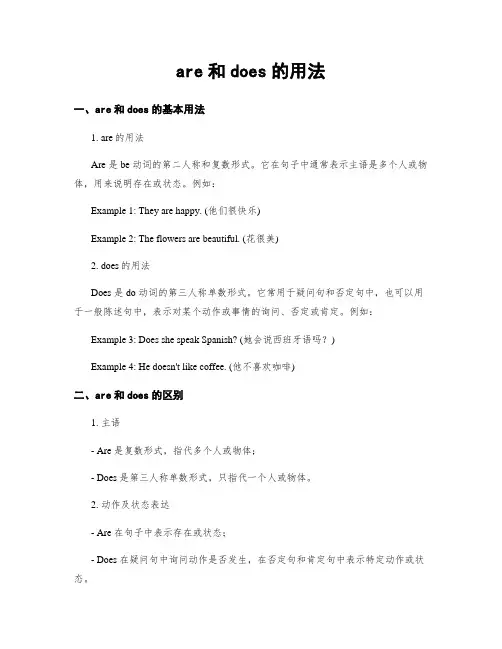
are和does的用法一、are和does的基本用法1. are的用法Are 是 be 动词的第二人称和复数形式。
它在句子中通常表示主语是多个人或物体,用来说明存在或状态。
例如:Example 1: They are happy. (他们很快乐)Example 2: The flowers are beautiful. (花很美)2. does的用法Does 是 do 动词的第三人称单数形式。
它常用于疑问句和否定句中,也可以用于一般陈述句中,表示对某个动作或事情的询问、否定或肯定。
例如:Example 3: Does she speak Spanish? (她会说西班牙语吗?)Example 4: He doesn't like coffee. (他不喜欢咖啡)二、are和does的区别1. 主语- Are 是复数形式,指代多个人或物体;- Does 是第三人称单数形式,只指代一个人或物体。
2. 动作及状态表达- Are 在句子中表示存在或状态;- Does 在疑问句中询问动作是否发生,在否定句和肯定句中表示特定动作或状态。
3. 变位规则- Are 在变为否定形式时,在 are 后面加 not;- Does 的否定形式为 does not 或 doesn't。
三、are和does在不同语境中的用法1. 疑问句疑问句常使用 does 和 are 来询问特定动作或状态。
例如:Example 5: Does she like ice cream? (她喜欢冰淇淋吗?)Example 6: Are they going to the party? (他们要去派对吗?)2. 否定句否定句中,does 和 are 表达出某种行为、习惯或状态不持续或不存在。
例如: Example 7: He doesn't play soccer. (他不踢足球)Example 8: We are not tired. (我们不累)3. 助动词和情态动词Are 和 does 可以与其他动词一起形成陈述句的肯定、否定和疑问形式。
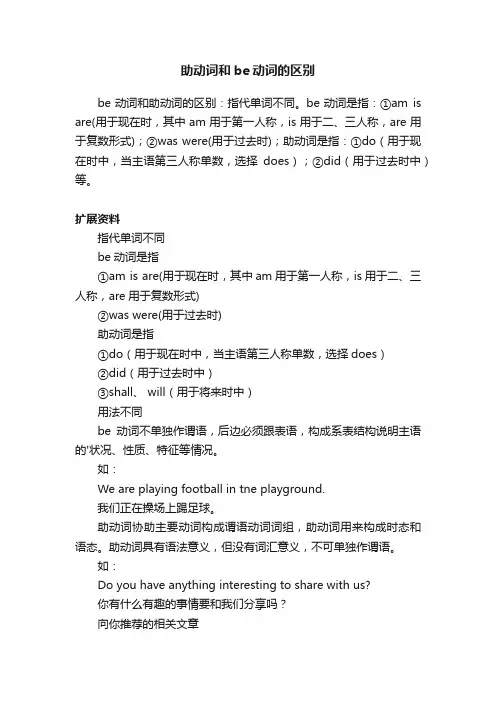
助动词和be动词的区别
be动词和助动词的区别:指代单词不同。
be动词是指:①am is are(用于现在时,其中am用于第一人称,is用于二、三人称,are用于复数形式);②was were(用于过去时);助动词是指:①do(用于现在时中,当主语第三人称单数,选择does);②did(用于过去时中)等。
扩展资料
指代单词不同
be动词是指
①am is are(用于现在时,其中am用于第一人称,is用于二、三人称,are用于复数形式)
②was were(用于过去时)
助动词是指
①do(用于现在时中,当主语第三人称单数,选择does)
②did(用于过去时中)
③shall、 will(用于将来时中)
用法不同
be动词不单独作谓语,后边必须跟表语,构成系表结构说明主语的'状况、性质、特征等情况。
如:
We are playing football in tne playground.
我们正在操场上踢足球。
助动词协助主要动词构成谓语动词词组,助动词用来构成时态和语态。
助动词具有语法意义,但没有词汇意义,不可单独作谓语。
如:
Do you have anything interesting to share with us?
你有什么有趣的事情要和我们分享吗?
向你推荐的相关文章
相关文章列表微信扫码分享。
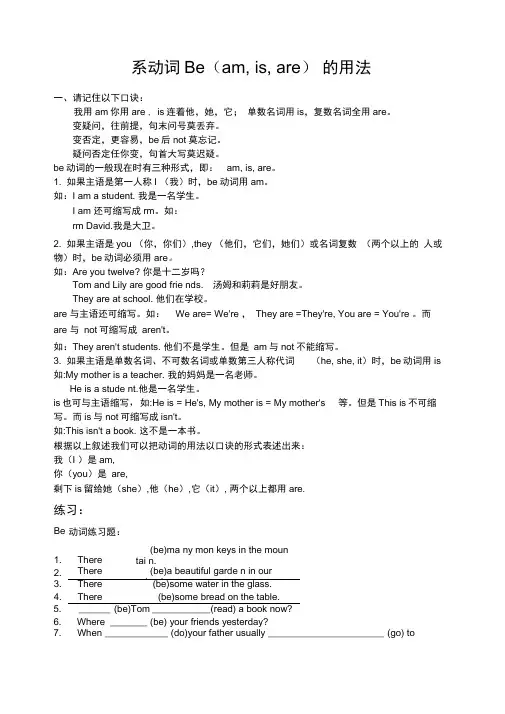
系动词Be(am, is, are)的用法一、请记住以下口诀:我用am你用are , is连着他,她,它;单数名词用is,复数名词全用are。
变疑问,往前提,句末问号莫丢弃。
变否定,更容易,be后not莫忘记。
疑问否定任你变,句首大写莫迟疑。
be动词的一般现在时有三种形式,即:am, is, are。
1. 如果主语是第一人称I (我)时,be动词用am。
如:I am a student. 我是一名学生。
I am 还可缩写成rm。
如:rm David.我是大卫。
2. 如果主语是you (你,你们),they (他们,它们,她们)或名词复数(两个以上的人或物)时,be动词必须用are。
如:Are you twelve? 你是十二岁吗?Tom and Lily are good frie nds. 汤姆和莉莉是好朋友。
They are at school. 他们在学校。
are 与主语还可缩写。
如:We are= We're ,They are =They're, You are = You're 。
而are 与not可缩写成aren't。
如:They aren't students. 他们不是学生。
但是am与not不能缩写。
3. 如果主语是单数名词、不可数名词或单数第三人称代词(he, she, it)时,be动词用is 如:My mother is a teacher. 我的妈妈是一名老师。
He is a stude nt.他是一名学生。
is也可与主语缩写,如:He is = He's, My mother is = My mother's 等。
但是This is不可缩写。
而is与not可缩写成isn't。
如:This isn't a book. 这不是一本书。
根据以上叙述我们可以把动词的用法以口诀的形式表述出来:我(I )是am,你(you)是are,剩下is留给她(she),他(he),它(it), 两个以上都用are.练习:Be 动词练习题:1. There(be)ma ny mon keys in the moun tai n.2. There (be)a beautiful garde n in ourschool3. There (be)some water in the glass.4. There (be)some bread on the table.5. ______ (be)Tom ___________ (read) a book now?6. Where _______ (be) your friends yesterday?7. When ____________ (do)your father usually ______________________ (go) towork?8. How old __________ (beO you last year?9. Which dog ________ (be)yours?10. Ten and two ________ (be) twelve.do和does的用法do这个词(does是第三人称单数形式),大体上从两方面来讲。
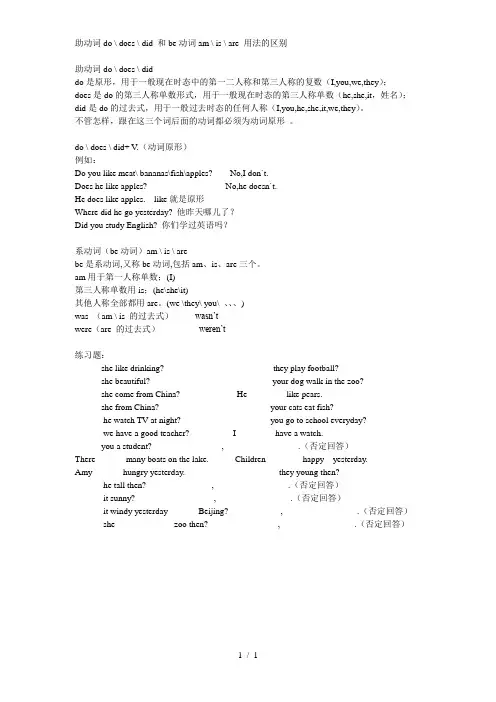
助动词do \ does \ did 和be动词am \ is \ are 用法的区别助动词do \ does \ diddo是原形,用于一般现在时态中的第一二人称和第三人称的复数(I,you,we,they);does是do的第三人称单数形式,用于一般现在时态的第三人称单数(he,she,it,姓名);did是do的过去式,用于一般过去时态的任何人称(I,you,he,she,it,we,they)。
不管怎样,跟在这三个词后面的动词都必须为动词原形。
do \ does \ did+ V.(动词原形)例如:Do you like meat\ bananas\fish\apples? No,I don`t.Does he like apples? No,he doesn`t.He does like apples. like就是原形Where did he go yesterday? 他昨天哪儿了?Did you study English? 你们学过英语吗?系动词(be动词)am \ is \ arebe是系动词,又称be动词,包括am、is、are三个。
am用于第一人称单数;(I)第三人称单数用is;(he\she\it)其他人称全部都用are。
(we \they\ you\ 、、、)was (am \ is 的过去式)wasn’twere(are 的过去式)weren’t练习题:______she like drinking? ________they play football?______she beautiful? ________your dog walk in the zoo?______she come from China? He ________ like pears.______she from China? _______ your cats eat fish?______ he watch TV at night? _______ you go to school everyday?______ we have a good teacher? I ________ have a watch.______you a student? , .(否定回答)There ______ many boats on the lake. Children ______ happy yesterday.Amy ______ hungry yesterday. ______ they young then?______ he tall then? , .(否定回答)______ it sunny? , .(否定回答)______ it windy yesterday ______ Beijing? , .(否定回答)______ she ______ ______ zoo then? , .(否定回答)1 / 1。
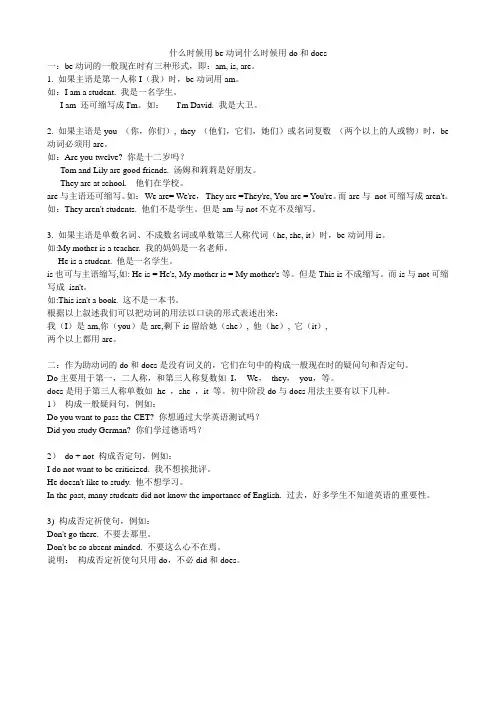
什么时候用be动词什么时候用do和does一:be动词的一般现在时有三种形式,即:am, is, are。
1. 如果主语是第一人称I(我)时,be动词用am。
如:I am a student. 我是一名学生。
I am 还可缩写成I'm。
如:I'm David. 我是大卫。
2. 如果主语是you (你,你们), they (他们,它们,她们)或名词复数(两个以上的人或物)时,be 动词必须用are。
如:Are you twelve? 你是十二岁吗?Tom and Lily are good friends. 汤姆和莉莉是好朋友。
They are at school. 他们在学校。
are与主语还可缩写。
如:We are= We're,They are =They're, You are = You're。
而are与not可缩写成aren't。
如:They aren't students. 他们不是学生。
但是am与not不克不及缩写。
3. 如果主语是单数名词、不成数名词或单数第三人称代词(he, she, it)时,be动词用is。
如:My mother is a teacher. 我的妈妈是一名老师。
He is a student. 他是一名学生。
is也可与主语缩写,如: He is = He's, My mother is = My mother's等。
但是This is不成缩写。
而is与not可缩写成isn't。
如:This isn't a book. 这不是一本书。
根据以上叙述我们可以把动词的用法以口诀的形式表述出来:我(I)是am,你(you)是are,剩下is留给她(she), 他(he), 它(it),两个以上都用are。
二:作为助动词的do和does是没有词义的,它们在句中的构成一般现在时的疑问句和否定句。
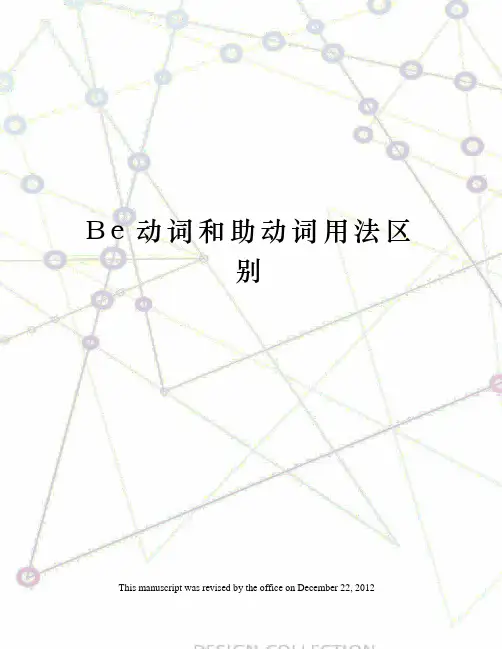
B e动词和助动词用法区别This manuscript was revised by the office on December 22, 2012B e动词和助动词用法区别:其实也是助动词(auxiliary verbs)。
英语动词大致可分为三种:助动词(auxiliary verbs),情态动词(modal verbs),实意动词(full verbs)。
助动词(auxiliary verbs):do,be,have。
没有实意,“帮助”别的动词,表示时态,否定和提问。
情态动词(modal verbs):can,must,may。
也是“帮助”别的动词,但是有自己的实意。
实意动词(full verbs):play,run,think。
其他有实意的动词。
可用作助动词(auxiliary verbs):1,be+Ving:所有的进行时态,如:2,be+过去分词:被动式。
也可用做实意动词(full verbs):be [bi]v.有;在;是。
你这样想,一个句子里要有动词吧。
再看看它们的名字,“”和“”,先说“”,(1)这名字里有动词,说明他是动词,句子里有他就不会有别的动词(除非这些动词以别的形式出现,这是后话)了,(2)“am,is,are,was,were”叫,是因为他们是be的不同形式再说“”,(1)一定要注意“助”,是帮助的意思,说明他不是动词,只是起到了辅助的作用,所以,他们就一定要与动词同时出现。
[记住啊,他们离不开动词,但是动词没有他们也是可以的](2)did,do,does只是do的不同形式,根据你所需要的时态来选择(1)用于,和疑问句am:第一人称单数(即只与 I 连用),用于现在时(一般现在,现在进行,只要那时态中是现在的就行)eg:①I am a girl.②I am eating an apple.③I am going to do my homework.[ 表将来,将来中只有这一种]is:,用于现在时(一般现在,现在进行,只要那时态中是现在的就行)(it就不举例了) eg:①She/He is a girl/boy.②He/She is eating an apple.③He/She is going to do his homework.[ 表将来,将来中只有这一种]are:单数,所有人称复数,用于现在时(一般现在,现在进行,只要那时态中是现在的就行)eg:①You are a girl.We/You(你们)/They are girls.②You are eating an apple.We/You(你们)/They are eating apples.③We/You(你们)/They are going to do our/your/their homework.[ 表将来,将来中只有这一种]was:第一人称单数,,用于过去时(一般过去,过去进行,只要那时态中是过去的就行)(it就不举例了)eg:①She/He was a girl/boy.一般过去·时回答be是一个连系动词,它有自己不同的形式现在时:be 进行时:being 过去时:was/were 过去分词:been 它的后面必须跟形容词或名词作表语,与之构成系表结构,充当句子的谓语。
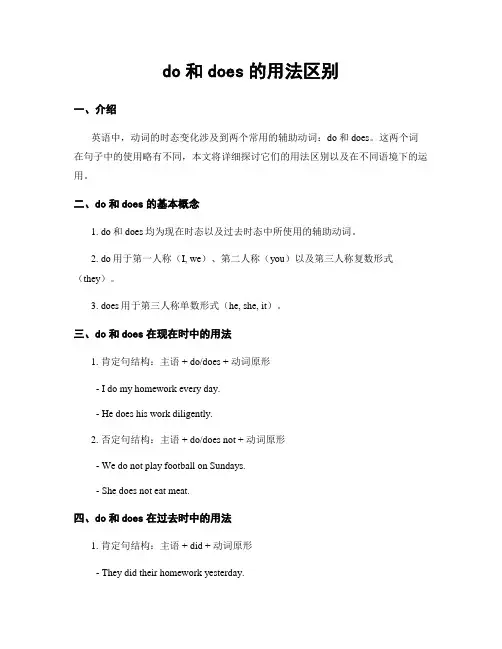
do和does的用法区别一、介绍英语中,动词的时态变化涉及到两个常用的辅助动词:do和does。
这两个词在句子中的使用略有不同,本文将详细探讨它们的用法区别以及在不同语境下的运用。
二、do和does的基本概念1. do和does均为现在时态以及过去时态中所使用的辅助动词。
2. do用于第一人称(I, we)、第二人称(you)以及第三人称复数形式(they)。
3. does用于第三人称单数形式(he, she, it)。
三、do和does在现在时中的用法1. 肯定句结构:主语 + do/does + 动词原形- I do my homework every day.- He does his work diligently.2. 否定句结构:主语 + do/does not + 动词原形- We do not play football on Sundays.- She does not eat meat.四、do和does在过去时中的用法1. 肯定句结构:主语 + did + 动词原形- They did their homework yesterday.- She did well in the exam.2. 否定句结构:主语 + did not + 动词原形- He did not go to the party last night.- We did not watch the movie.五、特殊疑问句中的do和does1. 用于疑问词who、what、where、when、why等开头的句子:- Who does the dishes in your house?- What do you want to eat for dinner?2. 疑问句结构:do/does + 主语 + 动词原形 + 其他?- Do you like playing sports?- Does she enjoy reading books?六、单复数主语在do和does中的用法差异1. 当主语为第一人称(复数)时,使用do。
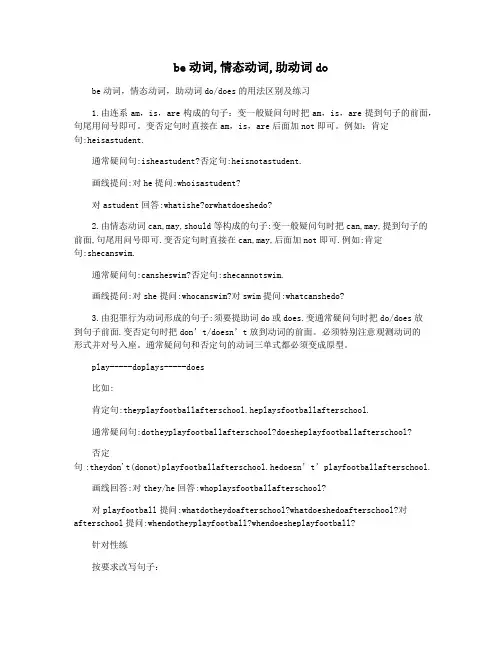
be动词,情态动词,助动词dobe动词,情态动词,助动词do/does的用法区别及练习1.由连系am,is,are构成的句子:变一般疑问句时把am,is,are提到句子的前面,句尾用问号即可。
变否定句时直接在am,is,are后面加not即可。
例如:肯定句:heisastudent.通常疑问句:isheastudent?否定句:heisnotastudent.画线提问:对he提问:whoisastudent?对astudent回答:whatishe?orwhatdoeshedo?2.由情态动词can,may,should等构成的句子:变一般疑问句时把can,may,提到句子的前面,句尾用问号即可.变否定句时直接在can,may,后面加not即可.例如:肯定句:shecanswim.通常疑问句:cansheswim?否定句:shecannotswim.画线提问:对she提问:whocanswim?对swim提问:whatcanshedo?3.由犯罪行为动词形成的句子:须要提助词do或does.变通常疑问句时把do/does放到句子前面.变否定句时把don’t/doesn’t放到动词的前面。
必须特别注意观测动词的形式并对号入座。
通常疑问句和否定句的动词三单式都必须变成原型。
play-----doplays-----does比如:肯定句:theyplayfootballafterschool.heplaysfootballafterschool.通常疑问句:dotheyplayfootballafterschool?doesheplayfootballafterschool?否定句:theydon't(donot)playfootballafterschool.hedoesn’t’playfootballafterschool.画线回答:对they/he回答:whoplaysfootballafterschool?对playfootball提问:whatdotheydoafterschool?whatdoeshedoafterschool?对afterschool提问:whendotheyplayfootball?whendoesheplayfootball?针对性练按要求改写句子:1.iknowtheanswer.(通常疑问句)______________________theanswer?2.wecanseesomebirds.(通常疑问句)____________see______birds?3.hedesignsclothes.(通常疑问句)______he________clothes?4.therearesomeflowersontheteach ers’desk.(通常疑问句)__________________flowersontheteachers’desk?5.therearesomeapplesonthetree. (否定句)there__________________applesonthetree.6.ithinkheisveryold.(否定句)i______thinkhe______veryold.7.pleasecolouritgreen.(否定句)____________colouritgreen.8.thesedoctorsarehelpful.(变小否定句)_____________________________.9.youmayhavesomehotdogs.(一般疑问句)_________________________________?.10.therearen’tanypearsinthebox.(同义句)thereare______pearsinthebox.11.thissignmeans“nosmoking”.what______thissig n_________?12.shelooksyoung.(改一般疑问句)________she_______young?13.sheisyoung.(改成通常疑问句)________________________?14.mypencilsareinthepencil-box.(对划线部分回答)____________yourpencils?15.igetupatsixeveryday.(对划线部分提问)______________________yougetupeveryday?16.theyliketowalkhome.(改成通常疑问句)______they_______________________________?17.thesearecars.(用buses改写成选择疑问句)arethesecars____________?18.myplantisonemonthold.(就划线部分回答)__________________________plant?19.twoboysareinourhouse.(改为therebe句型)____________twoboysinourhouse.20.myplanthastwogreenleaves.____________________ ___________________plant__________?21.missligoestohongkongbyplane.(同义句)missli_________________hongkong.22.thewomenworkintheshoefactory.(就划线部分回答)____________________women__________?23.heishappy,becauseheisgoingtotakeatriptomorrow.(就划线部分回答)_____________________________?24.myfathercancookthemeals.(就划线部分提问)_______________________father__________?25.youshouldaddwateroften.(一般疑问句)____________________wateroften?一、变否定句时相关词的改变肯定句变否定句时,除将谓语变为否定式外,句中其他词语也可能随之改变,如将some改成any,too和also改成either,already改成yet,and改成or等:therearesomebirdsinthetree.树上有些鸟。
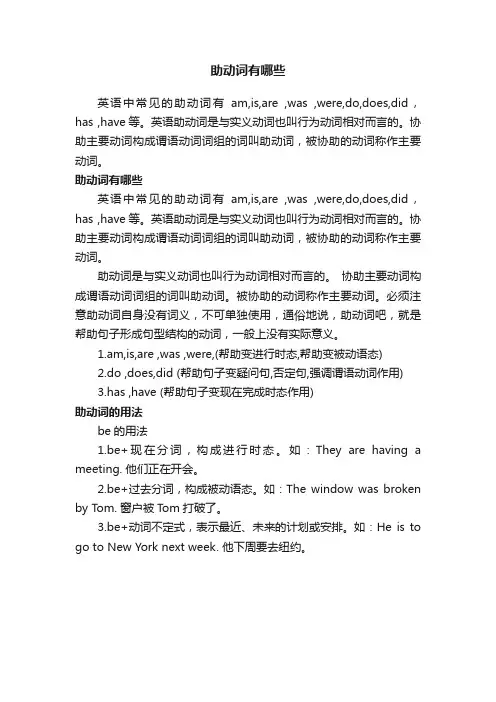
助动词有哪些
英语中常见的助动词有am,is,are ,was ,were,do,does,did,has ,have等。
英语助动词是与实义动词也叫行为动词相对而言的。
协助主要动词构成谓语动词词组的词叫助动词,被协助的动词称作主要动词。
助动词有哪些
英语中常见的助动词有am,is,are ,was ,were,do,does,did,has ,have等。
英语助动词是与实义动词也叫行为动词相对而言的。
协助主要动词构成谓语动词词组的词叫助动词,被协助的动词称作主要动词。
助动词是与实义动词也叫行为动词相对而言的。
协助主要动词构成谓语动词词组的词叫助动词。
被协助的动词称作主要动词。
必须注意助动词自身没有词义,不可单独使用,通俗地说,助动词吧,就是帮助句子形成句型结构的动词,一般上没有实际意义。
1.am,is,are ,was ,were,(帮助变进行时态,帮助变被动语态)
2.do ,does,did (帮助句子变疑问句,否定句,强调谓语动词作用)
3.has ,have (帮助句子变现在完成时态作用)
助动词的用法
be的用法
1.be+现在分词,构成进行时态。
如:They are having a meeting. 他们正在开会。
2.be+过去分词,构成被动语态。
如:The window was broken by Tom. 窗户被T om打破了。
3.be+动词不定式,表示最近、未来的计划或安排。
如:He is to go to New York next week. 他下周要去纽约。

Be动词和助动词的用法区别1、be动词的用法。
be am / is are 现在时was were 过去时单数复数英语中,be动词选用单数还是复数,要由主语来定,主语是单数,就用单数,反之用复数。
◆句中含有be动词时:肯定句:主语+be +其他否定句:主语+be +not +其他一般疑问句:Be +主语+其他+?特殊疑问句:疑问词(what / who / when / where)+be +主语+其他+?I am a teacher. You are right.She is 16 years old. My father is at home.The students are playing games. My teacher was ill yesterday.There is a picture on the wall.There are two books on the table.★ be动词用法歌:我用am,你用are,is 连接他她它。
单数名词用is,复数名词全用are。
变疑问,往前提,句末问号莫丢弃;变否定,更容易,be后not莫忘记;疑问否定任你变,句首大写莫迟疑。
★ be动词作谓语,它后面一般跟名词、形容词或介词短语。
2、助动词的用法。
英语句子按正常语序是“什么人或事物” + “做什么”,即,我们常说的“主语+ 谓语+ 其他”。
①主语为I 或复数名词、代词时:肯定句:I / We / They / The students +动词原形+其他+。
We watch TV every night.变否定:主语+don’t +动词原形+其他+。
We don’t watch TV every night.一般疑问句Do + 主语+ 动词原形+ 其他+ ?Do you watch TV every night?Yes, we do. / No, we don’t.特殊疑问句:疑问词+ do + 主语+ 动词原形+ 其他+ ?How often do you watch TV?②主语为单数名词或代词时:肯定句:主语+ 动词第三人称单数形式+ 其他+ 。
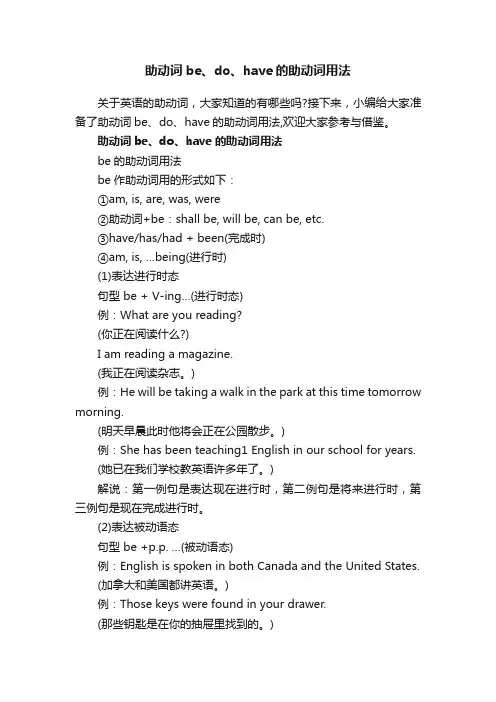
助动词be、do、have的助动词用法关于英语的助动词,大家知道的有哪些吗?接下来,小编给大家准备了助动词be、do、have的助动词用法,欢迎大家参考与借鉴。
助动词be、do、have的助动词用法be的助动词用法be作助动词用的形式如下:①am, is, are, was, were②助动词+be:shall be, will be, can be, etc.③have/has/had + been(完成时)④am, is, …being(进行时)(1)表达进行时态句型 be + V-ing…(进行时态)例:What are you reading?(你正在阅读什么?)I am reading a magazine.(我正在阅读杂志。
)例:He will be taking a walk in the park at this time tomorrow morning.(明天早晨此时他将会正在公园散步。
)例:She has been teaching1 English in our school for years.(她已在我们学校教英语许多年了。
)解说:第一例句是表达现在进行时,第二例句是将来进行时,第三例句是现在完成进行时。
(2)表达被动语态句型be +p.p. …(被动语态)例:English is spoken in both Canada and the United States.(加拿大和美国都讲英语。
)例:Those keys were found in your drawer.(那些钥匙是在你的抽屉里找到的。
)例:It can be done much faster in this way.(这件工作用这个方法可以更加快速地做好。
)have的助动词用法(1)表达完成时态句型have (has, had1) +p.p. …句型can (could2), …have + p.p.例:He can’t have said3 such4 a foolish5 word.(他不像是会说了这样傻的话。
助动词do和does的区别和用法
区别:
意思不同:
1、do意思:做,干,办(某事);(以某种方式)做;行动;表现;(问询或谈论时用)进展,进行。
2、does意思:用于实义动词前构成否定句和疑问句;构成附加疑问句;代替实义动词以避免重复。
用法不同:
1、do用法:do用来构成一般现在时和一般过去时的疑问或否定式,其后要跟原形动词。
在问句中,do在语法上是需要的,但习惯上可以省略(有时含主语),特别在口语中。
2、does用法:作及物动词时可接名词、代词、动名词、从句作宾语,也可接同源宾语;还可接双宾语(其间接宾语可以转化为介词to的宾语)。
侧重点不同:
1、do侧重点:do是动词原形,用于第一人称、第三人称的复数(I/you/we/they)。
2、does侧重点:does用于第三人称单数(he/she/it)does用于第三人称单数。
be动词与助动词的用法第一篇:be动词与助动词的用法be动词与助动词的用法1.陈述句:be动词第一人称用am,第二人称用are,第三人称单数用is复数用are. 助动词do一般省略,直接用动词,注意动词时态和人称变化.有时在动词前加do,表示强调,加强语气.如:Do be quiet!2.疑问句:be动词直接提前,其他部分不变(由陈述句转变).助动词do同样,由省略直接提前放置,后面动词不变,注意do 的时态和人称变化.3.否定句:be动词和助动词do后面加not. be作助动词用的形式如下:①am, is, are, was, were ②助动词+be:shall be, will be, can be, etc. ③have/has/had + been(完成时)④am, is, …being(进行时)(1)表达进行时态句型 be + V-ing…(进行时态)例:What are you reading? (你正在阅读什么?) I am reading a magazine. (我正在阅读杂志。
)例:He will be taking a walk in the park at this timetomorrow morning. (明天早晨此时他将会正在公园散步。
)例:She has been teaching English in our school for years. (她已在我们学校教英语许多年了。
)解说第一例句是表达现在进行时,第二例句是将来进行时,第三例句是现在完成进行时。
(2)表达被动语态句型be +p.p. …(被动语态)例:English is spoken in both Canada and the United States. (加拿大和美国都讲英语。
)例:Those keys were found in your drawer. (那些钥匙是在你的抽屉里找到的。
小学英语语法:动词用法动词是表示动作或行为的词。
按其词义和在句子中的作用能够分为连系动词、助动词、情态动词和行为动词。
1、be动词(am,is,are)① be动词做谓语时,要与主语在人称和数上保持一致。
用法口诀:我用am,你用are,is 用在他、她、它,复数全用are。
如:I am a teacher. You are a student. She is a nurse. We are Chinese.② be动词的否定形式:am not(无缩写形式),is not=isn’t,are not=aren’t2、助动词(do,does,did)① do,does用于一般现在时,does用于第三人称单数,其他人称和数用do。
其过去式did用于一般过去时。
他们通常用在疑问句和否定句中。
助动词后动词要用原形。
如:Do you like this film?Does she like playing football?I didn’t go to school yesterday.② 否定形式:do not = don’t,does not =doesn’t,didnot=didn’t3、情态动词(can,may,must,should,will,would,shall等)情态动词表示说话人对某一动作或状态的态度,表示“可能”,“能够”,“需要”,“必须”,“理应”等意思。
情态动词没有人称和数的变化,后面的动词要用原形。
1)can和may都能够用来表示请求或允许,但may比can更正式,更客气些。
如: Can I use your pen? May I come in?2)must和should① must意为“必须,理应”,含有一种命令的语气,比较生硬,不容商量。
② should意为“理应,应该”,表示建议或劝告,语气比较委婉,客气。
如:You must finish your homework before you go to bed.You should stay in bed and have a good rest.3)will和would用于疑问句,表示说话人向对方提出请求或询问,用would比will更委婉,更客气。
Be动词和助动词用法区别其实be动词也是助动词(auxiliary verbs)。
英语动词大致可分为三种:助动词(auxiliary verbs),情态动词(modal verbs),实意动词(full verbs)。
助动词(auxiliary verbs):do,be,have。
没有实意,“帮助”别的动词,表示时态,否定和提问。
情态动词(modal verbs):can,must,may。
也是“帮助”别的动词,但是有自己的实意。
实意动词(full verbs):play,run,think。
其他有实意的动词。
be动词可用作助动词(auxiliary verbs):1,be+Ving:所有的进行时态,如:2,be+过去分词:被动式。
be动词也可用做实意动词(full verbs):be[bi]v.有;在;是。
你这样想,一个句子里要有动词吧。
再看看它们的名字,“be 动词”和“助动词”,先说“be动词”,(1)这名字里有动词,说明他是动词,句子里有他就不会有别的动词(除非这些动词以别的形式出现,这是后话)了,(2)“am,is,are,was,were”叫be动词,是因为他们是be的不同形式再说“助动词”,(1)一定要注意“助”,是帮助的意思,说明他不是动词,只是起到了辅助的作用,所以,他们就一定要与动词同时出现。
[记住啊,他们离不开动词,但是动词没有他们也是可以的](2)did,do,does只是do的不同形式,根据你所需要的时态来选择(1)用于肯定句,否定句和疑问句am:第一人称单数(即只与I连用),用于现在时(一般现在,现在进行,只要那时态中是现在的就行)eg:①I am a girl.一般现在时②I am eating an apple.现在进行时③I am going to do my homework.[be going to表将来,将来中只有这一种]is:第三人称单数,用于现在时(一般现在,现在进行,只要那时态中是现在的就行)(it就不举例了)eg:①She/He is a girl/boy.一般现在时②He/She is eating an apple.现在进行时③He/She is going to do his homework.[be going to表将来,将来中只有这一种]are:第二人称单数,所有人称复数,用于现在时(一般现在,现在进行,只要那时态中是现在的就行)eg:①You are a girl.We/You(你们)/They are girls.一般现在时②You are eating an apple.We/You(你们)/They are eating apples.现在进行时③We/You(你们)/They are going to do our/your/their homework.[be going to表将来,将来中只有这一种]was:第一人称单数,第三人称单数,用于过去时(一般过去,过去进行,只要那时态中是过去的就行)(it就不举例了) eg:①She/He was a girl/boy.一般过去·时回答be是一个连系动词,它有自己不同的形式现在时:be进行时:being过去时:was/were过去分词:been它的后面必须跟形容词或名词作表语,与之构成系表结构,充当句子的谓语。
is are am的区别和用法is are am的区别和用法is, are 和 am 是英语中最常用的三个助动词,它们都可以表示“是”的意思,但三者在形式和用法上有所不同。
一、is, are 和 am 的构成1、is 是第一人称单数助动词,由助动词 be 加上-s 构成。
2、are 是第二人称复数助动词,由助动词 be 加上-re 构成。
3、am 是第一人称单数助动词,也是助动词 be 的一种变形。
二、is, are 和 am 的区别1、is 主要用于第一人称单数,表示“我是”的意思;2、are 主要用于第二人称复数,表示“你们(复数)是”的意思;3、am 也可以用于第一人称单数,表示“我是”的意思,但与is 的用法有所不同。
三、is, are 和 am 的用法1、is 用于第一人称单数,一般用来表示主语是人或物时,表示“我是”的意思,主语可以是人,也可以是物,例如:I am a student. 我是一名学生。
The book is on the desk. 书在桌子上。
2、are 用于第二人称复数,一般用来表示主语是人或物时,表示“你们(复数)是”的意思,主语可以是人,也可以是物,例如:You are my friends. 你们是我的朋友。
These books are new. 这些书都是新的。
3、am 用于第一人称单数,一般用来表示主语是人时,表示“我是”的意思,例如:I am a teacher. 我是一名老师。
4、am 可以用于表示正在进行的动作,表示“我正在……”的意思,例如:I am reading a book. 我正在读书。
5、am 可以用于表示将来的动作,表示“我将要……”的意思,例如:I am going to play football tomorrow. 我明天将要去踢足球。
6、am 可以用于表示习惯或经常重复的动作,表示“我经常……”的意思,例如:I am usually late for school. 我上学通常会迟到。
are is do does的用法
are,is,do,does是英语中常用的几个动词形式,它们的用法如下:
1. are是be动词的现在时复数形式,用于描述多个人或物的状态或特征,如:They are happy.(他们很开心。
)
2. is是be动词的现在时单数形式,用于描述一个人或物的状态或特征,如:She is beautiful.(她很漂亮。
)
3. do是动词do的现在时单、复数形式,用于构成一般现在时的肯定句和疑问句,如:I do my homework every day.(我每天都做作业。
)Do you like coffee?(你喜欢咖啡吗?)
4. does是动词do的第三人称单数形式,用于构成一般现在时的肯定句和疑问句,如:He does his homework every day.(他每天都做作业。
)Does she like coffee?(她喜欢咖啡吗?)以上是are,is,do,does的基本用法,需要注意的是,它们在不同的语境中可能有不同的含义和用法,需要根据具体情况进行理解和运用。
- 1 -。
助动词do \ does \ did 和be动词am \ is \ are 用法的区别
助动词do \ does \ did
do是原形,用于一般现在时态中的第一二人称和第三人称的复数(I,you,we,they);does是do的第三人称单数形式,用于一般现在时态的第三人称单数(he,she,it,姓名);did是do的过去式,用于一般过去时态的任何人称(I,you,he,she,it,we,they)。
不管怎样,跟在这三个词后面的动词都必须为动词原形。
do \ does \ did+ V.(动词原形)
例如:
Do you like meat\ bananas\fish\apples? No,I don`t.
Does he like apples? No,he doesn`t.
He does like apples. like就是原形
Where did he go yesterday? 他昨天哪儿了?
Did you study English? 你们学过英语吗?
系动词(be动词)am \ is \ are
be是系动词,又称be动词,包括am、is、are三个。
am用于第一人称单数;(I)
第三人称单数用is;(he\she\it)
其他人称全部都用are。
(we \they\ you\ 、、、)
was (am \ is 的过去式)wasn’t
were(are 的过去式)weren’t
练习题:
______she like drinking? ________they play football?
______she beautiful? ________your dog walk in the zoo?
______she come from China? He ________ like pears.
______she from China? _______ your cats eat fish?
______ he watch TV at night? _______ you go to school everyday?
______ we have a good teacher? I ________ have a watch.
______you a student? , .(否定回答)
There ______ many boats on the lake. Children ______ happy yesterday.
Amy ______ hungry yesterday. ______ they young then?
______ he tall then? , .(否定回答)
______ it sunny? , .(否定回答)
______ it windy yesterday ______ Beijing? , .(否定回答)______ she ______ ______ zoo then? , .(否定回答)
1 / 1。